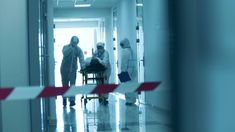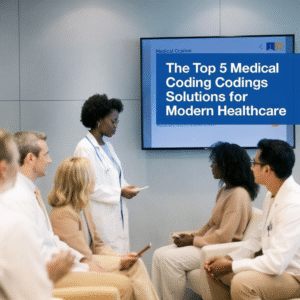The Best Medical Coding Solutions for Modern Healthcare: The Key to Your Center’s Financial Success
Medical Coding Solutions
Medical Coding Solutions
In the dynamic ecosystem of contemporary healthcare, where digital transformation and regulatory complexity converge, medical coding emerges as the differentiating factor between the financial success and failure of any healthcare institution. More than just an administrative process, it represents the nerve center that determines the economic sustainability of clinics, private practices, and hospitals throughout Europe.

The Current Landscape: Challenges and Opportunities
Contemporary medical coding transcends the mere assignment of alphanumeric codes. It is a strategic process that translates clinical complexity into a universal financial language, enabling every medical intervention, diagnosis, and procedure to be converted into legitimate and sustainable revenue.
Exponential Complexity of the Regulatory Environment
The European regulatory landscape presents unique challenges that require specialized solutions:
Multiple Classification Systems: Each European country maintains its own specificities within the common ICD-10 framework. In Spain, the National Health System uses the MBDS (Minimum Basic Data Set), while private mutual insurance companies and insurers implement their own coding systems. France operates with the CCAM (Common Classification of Medical Procedures), and Germany with the German DRG system (G-DRG).
Constant Updates: The codes evolve quarterly, incorporating new pathologies, innovative procedures, and regulatory adjustments. The COVID-19 pandemic introduced more than 200 new codes related to SARS-CoV-2 and its after-effects.
Growing Financial Pressure: Operating margins are squeezed while healthcare costs rise. Each coding error can represent losses of between €500 and €5,000 per claim, depending on the complexity of the case.
Solutions Architecture: Converged Technology and Services
A. Cutting-edge Technological Solutions
1. Artificial Intelligence-Assisted Coding (AI-CAC) Platforms
Next-generation AI-CAC solutions integrate natural language processing (NLP) algorithms with deep learning models specifically trained in Spanish and European medical terminology.
Advanced Features:
- Contextual Semantic Analysis: Algorithms understand not only individual terms, but complex medical contexts, identifying relationships between symptoms, diagnoses, and procedures.
- Missing Code Detection: Automatic identification of undocumented procedures or diagnoses that may warrant additional codes
- Real-Time Cross-Validation: Instant consistency check between primary and secondary codes
- Specificity Optimization: Automatic suggestions to maximize diagnostic and procedural accuracy
Demonstrable ROI:
- 40-60% reduction in coding time per case
- 15-25% increase in coding accuracy
- 30-50% decrease in denials due to code errors
- 20-35% improvement in revenue capture through code optimization
2. Integrated Revenue Cycle Management Ecosystems (RCM 360°)
These platforms represent the natural evolution toward the comprehensive automation of the healthcare financial cycle.
Interconnected Modules:
- Patient Management: From registration to discharge, including automatic insurance verification
- Intelligent Coding: Native integration with AI-CAC systems
- Dynamic Billing: Automatic invoice generation with prior validation
- Claims Management: Automated Tracking and Smart Forwarding
- Predictive Analytics: Proactive Identification of Financial Risks

3. Predictive Audit and Risk Analysis
AI-based audit systems represent the most advanced frontier in error prevention and revenue optimization.
Vanguard Capabilities:
- Predictive Denial Models: Algorithms that identify claims with a high probability of rejection before submission
- Pattern Analysis: Detecting inconsistencies in coding patterns that may indicate audit risk
- Automatic Benchmarking: Continuous comparison with specialty standards and deviation alerts
- Documentation Optimization: Specific suggestions for improving clinical documentation and maximizing coding accuracy
B. Specialized Outsourcing Solutions
1. Premium Medical Coding Outsourcing
Modern outsourcing transcends the traditional service model, offering strategic partnerships that include:
Differentiated Services:
- Specialized Teams by Specialty: Certified coders with specific expertise in cardiology, oncology, plastic surgery, etc.
- Real-Time Coding: Case processing within 24-48 hours of discharge
- Proactive Denial Management: Not just coding, but comprehensive follow-up until resolution
- Optimization Consulting: Periodic analysis to identify opportunities for improvement in documentation and processes
Performance Guarantees:
- Minimum guaranteed accuracy of 95-98%
- 24-72 hour processing SLA depending on complexity
- Denial rate due to code errors less than 2%
- Average revenue increase of 8-15% in the first year
2. Revenue Cycle Management (RCM) Integral
Complete RCM solutions offer complete transfer of administrative financial responsibility:
Comprehensive Services:
- Comprehensive Admissions Management: Insurance verification, prior authorizations, cost estimates for patients
- Unified Coding and Billing: Continuous process from documentation to collection
- Specialized Accounts Receivable Management: Customized monitoring based on the type of payer
- Patient Payment Management: From initial estimates to payment plans and collections
Strategic Selection Framework: Advanced Evaluation Criteria
Fundamental Technical Criteria
1. Technological Integration
- Native API support for Spanish EHR systems (Savac, Selene, etc.)
- Integration capacity with hospital systems (SAP Healthcare, Oracle Health)
- Cloud-native architecture with geographic redundancy in Europe
- Implementation time less than 3-6 months
2. Compliance and Security
- ISO 27001 certification specific to health data
- GDPR compliance with independent annual audits
- ENS (National Security Scheme) Certification for public bodies
- Comprehensive DPA (Data Processing Agreement) contracts
3. Expertise Local
- Certified coders in Spanish systems (CCS, CIAS)
- Specific knowledge of mutual insurance companies (MUFACE, MUGEJU, ISFAS)
- Experience with Spanish private insurers
- Understanding regional peculiarities
Strategic Financial Criteria
Optimized Investment Models:
1. CAC Software: Initial investment €15,000-€50,000, typical ROI 18-24 months 2. Premium Outsourcing: 4-8% of gross revenue, immediate ROI 3. Comprehensive RCM: 6-12% of net collections, ROI 6-12 months
Evaluation Metrics:
- EBITDA Impact: Typical 3-7% EBITDA improvement
- Cash Flow Acceleration: 15-30 days reduction in collections
- Administrative Cost Reduction: 20-40% reduction in administrative costs
Emerging Trends and the Future of the Sector
Generative Artificial Intelligence
Generative AI models specifically trained on Spanish medical documentation are beginning to offer:
- Automatic generation of discharge summaries
- Optimizing documentation to maximize code
- Machine translation between clinical terminology and codes
Blockchain for Auditing
Implementing blockchain in the coding process offers:
- Immutable traceability of coding decisions
- Automatic and transparent audits
- Reduction of disputes with payers
Telemedicine and Virtual Coding
The growth of telemedicine requires new coding approaches:
- Specific codes for virtual consultations
- Integration with teleconsultation platforms
- Automated documentation of remote sessions

Success Stories: Real Transformations
Private Multispecialty Clinic (Madrid)
Initial Situation: 40% denials, 85 days average collection time Solution: Comprehensive RCM with specialized coding Results: 12% denials, 45 days average collection time, +22% net income
Private Hospital (Barcelona)
Initial Situation: Manual coding, 200 cases/day Solution: AI-CAC + hybrid outsourcing Results: 400 cases/day, 95% accuracy, -60% processing time
Roadmap for Implementation
Phase 1: Evaluation and Diagnosis (30-45 days)
- Complete audit of current processes
- Financial performance analysis
- Identification of gaps and opportunities
- Definition of target KPIs
Phase 2: Selection and Hiring (45-60 days)
- RFP (Request for Proposal) estructurada
- Technical and commercial evaluation
- Negotiation of contracts and SLAs
- Implementation planning
Phase 3: Implementation and Optimization (90-120 days)
- Data and systems migration
- Team training
- Parallelism and validation period
- Continuous optimization
Phase 4: Monitoring and Continuous Improvement (Ongoing)
- Real-time KPI Dashboard
- Monthly performance reviews
- Automatic regulatory updates
- Expansion of functionalities
Conclusion: The Strategic Imperative
Medical coding has evolved from an administrative process to a key strategic differentiator. Healthcare organizations that recognize this transformation and invest in advanced solutions not only improve their financial health but also build sustainable competitive advantages in an increasingly demanding market.
The choice between in-house technology, specialized outsourcing, or hybrid models must be based on a rigorous assessment of internal capabilities, strategic objectives, and available resources. However, what is beyond debate is the need to act: in an environment where every euro counts and every mistake costs, inaction represents the greatest risk of all.
The future belongs to organizations that embrace technological innovation without losing sight of human expertise, that invest in solutions that not only solve current problems but also anticipate future challenges. On this journey toward operational excellence, medical coding is proving itself not as a destination, but as the vehicle that drives sustainability and growth in the 21st-century healthcare sector.



